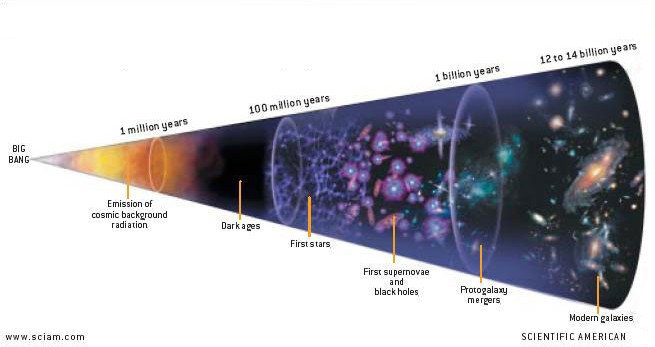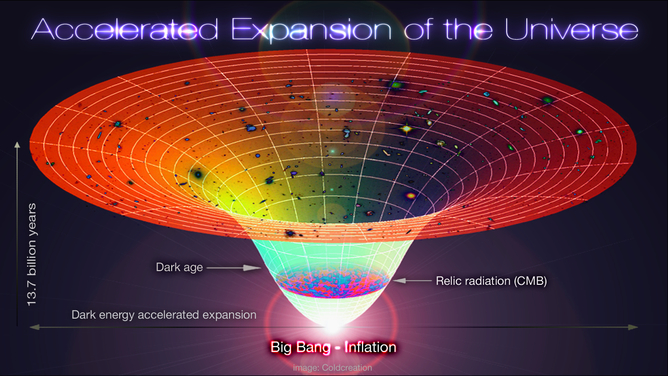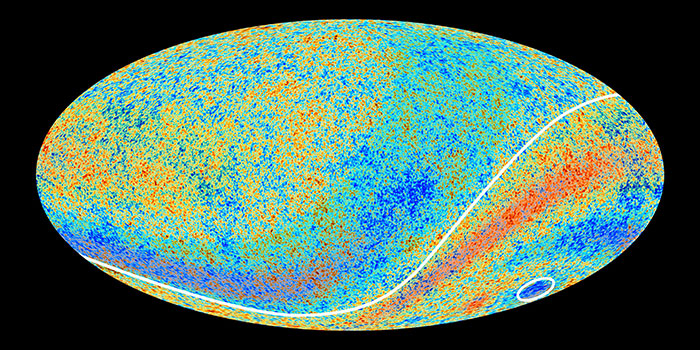Problems with the Big Bang
For most cosmologists, the debate on interpreting the redshifts as the expansion of the universe is long settled. It can almost be directly observed that time began around 14 billion years ago. When we look into space and thus back in time, we can see that the most distant galaxies are small and disordered, unlike the galaxies nearby.
In the last ten years however, we have observed massive, dusty galaxies with ordered features and shut down star formation at all distances, well before they are predicted to have appeared[1][2][3][4][5][6][7][8][9].
Mature galaxies in the "early" universe
The distant universe isn't meeting our expectations for when galaxies become massive, dusty, spiraled, barred, disced, bulged, and have shut down star formation:
-
A massive stellar bulge in a regularly rotating galaxy
1.2 billion years after the Big Bang[1]
Lelli et al. (1) report a galaxy that had evolved features (both a disk and a bulge) when only 1.2 billion years had elapsed since the Big Bang (∼12.5 billion years ago) (see the figure). This finding suggests that the processes that generate the key features of a mature galaxy arose more rapidly than has been thought.
-
A cold, massive, rotating disk galaxy 1.5 billion years after the Big Bang
[2]
The existence of such a massive, rotationally supported, cold disk galaxy when the Universe was only 1.5 billion years old favours formation through either cold-mode accretion or mergers, although its large rotational velocity and large content of cold gas remain challenging to reproduce with most numerical simulations.
-
A dynamically cold disk galaxy in the early Universe[3]
Interferometric imaging at a spatial resolution of about 60 pc reveals a ratio of rotational-to-random motions of V/σ = 9.7 ± 0.4, which is at least four times larger than expected from any galaxy evolution model at this epoch, but similar to the ratios of spiral galaxies in the local Universe.
-
A dominant population of optically invisible massive galaxies in the early Universe
[4]
Such a high abundance of massive and dusty galaxies in the early Universe challenges our understanding of massive-galaxy formation.
-
Earliest giant galaxies: The birth of monsters
[5]
"To complicate things further, if massive galaxies are unexpectedly dustier in the early Universe than astronomers predict then even UltraVISTA wouldn't be able to detect them. If this is indeed the case, the currently-held picture of how galaxies formed in the early Universe may also require a complete overhaul."
-
A dusty, normal galaxy in the epoch of reionization
[6]
The galaxy is highly evolved: it has a large stellar mass, and is heavily enriched in dust, with a dust-to-gas ratio close to that of the Milky Way. Dusty, evolved galaxies are thus present among the fainter star-forming population at z > 7, in spite of the very short time since they first appeared.
-
Some galaxies in the early universe grew up quickly
[7]
Fifteen mature galaxies were found at a record-breaking average distance of 12 billion light years, when the universe was just 1.6 billion years old. Their existence at such an early time raises new questions about what forced them to grow up so quickly
-
Galaxy Zoo: CANDELS Barred Disks and Bar Fractions
[8]
The newly classified galaxies are striking in that they look a lot like those in today's universe, with disks, bars and spiral arms. But theorists predict that these should have taken another 2 billion years to begin to form, so things seem to have been settling down a lot earlier than expected.
-
Spitzer Splash Project Dives Deep for Galaxies
[9]
"The findings cast doubt on current models of galaxy formation, which struggle to explain how these remote and young galaxies grew so big so fast."
Is the expansion of the universe a fact? This was debated in the 1930's and was very violently interrupted by World War II. This is an unconventional argument to make, but science does not operate in a vacuum. And while the war made science a priority, and produced many giant leaps forward, the science of galactic nebulae was not one of those priorities.
To illustrate how drastic an interruption this was, in December of 1941, Edwin Hubble, the man credited for discovering the expanding universe, announced that he had refuted the expanding universe theory. Soon, he would no longer be looking through telescopes, but instead working in a windtunnel on ballistics research for the war effort.
In the 1950's, a new generation came back to the telescopes, armed with two expanding universe theories: the big bang theory, where the universe was smaller in the past, and the steady-state theory, where expansion of space produces matter, keeping the density of the universe the same.
In the 1960's the discovery of the cosmic microwave background (CMB) led to the acceptance of the big bang theory over the steady state theory. It looked like this:

Big Bang 1.0: Expansion
By the 1970's, it was apparent this theory had some problems (Horizon Problem, Flatness Problem, Magnetic Monopole Problem) which were solved by a period of super-expansion right after the big bang. This period is called cosmic inflation, and it looks like this:

Big Bang 2.0: Inflation
By the 1990's, as mentioned before, the measurements of distances and redshifts showed that the expansion of the universe must be accelerating:

Big Bang 3.0: Acceleration
Today, Big Bang 3.0, also known as LambdaCDM, is famously in conflict with independent measurements[10][11][12][13][14]. A Big Bang 4.0 might be on the way.
Over the decades, some have criticized the big bang theory for the continual need for major, ad hoc changes to fit observations.
Modern Cosmology: Science or Folktale?
In its original form, an expanding Einstein model had an attractive, economic elegance. Alas, it has since run into serious difficulties, which have been cured only by sticking on some ugly bandages: inflation to cover horizon and flatness problems; overwhelming amounts of dark matter to provide internal structure; and dark energy, whatever that might be, to explain the seemingly recent acceleration. A skeptic is entitled to feel that a negative significance, after so much time, effort and trimming, is nothing more than one would expect of a folktale constantly re-edited to fit inconvenient new observations.
Modern Cosmology: Science or Folktale? (2007)
More:
But viable alternatives to the expanding universe theory face considerable obstacles, such as explaining the CMB. If the energy of the CMB is not from the beginning of the universe, what is it from? Is it even related to the redshifts? Without a valid explanation for the CMB, a theory of redshifts, no matter how good it is, is not good enough to topple the expanding universe theory.
Doesn't the Cosmic Microwave Background confirm an expanding universe?
The expanding universe theory predicts we observe the same background temperature in all directions.
This prediction seemed to hold until 2003 when anomalies appeared, which were confirmed in 2013:

Two Cosmic Microwave Background anomalous features hinted at by Planck's predecessor, NASA's Wilkinson Microwave Anisotropy Probe (WMAP), are confirmed in the new high precision data from Planck. One is an asymmetry in the average temperatures on opposite hemispheres of the sky (indicated by the curved line), with slightly higher average temperatures in the southern ecliptic hemisphere and slightly lower average temperatures in the northern ecliptic hemisphere. This runs counter to the prediction made by the standard model that the Universe should be broadly similar in any direction we look. There is also a cold spot that extends over a patch of sky that is much larger than expected (circled). In this image the anomalous regions have been enhanced with red and blue shading to make them more clearly visible.
https://sci.esa.int/web/planck/-/51559-hemispheric-asymmetry-and-cold-spot-in-the-cosmic-microwave-background
This raises the question of where the CMB Cold Spot might appear to other observers.
For instance, imagine observers at the north and south poles of our observable universe:

We see a cold spot to the south. Does the south observer see a cold spot to their south? Does the north observer see the same CMB anomalies as we do?
This is a question the expanding universe theory doesn't have a clear answer for.
However, if the observable region is, as Hubble puts it, "an insignificant sample of a universe that extends indefinitely in space and in time", then there are no anomalies or questions. The cold spot is to our south, but to the southern observer the cold spot is in their vicinity.
One thing to keep in mind is that before the expanding theory even existed, Arthur Eddington calculated the temperature of starlight in our galaxy to be 3.18 Kelvin. As such, the CMB may just be photons limping in from galaxies 14 billion light years away, right before the temperature of space takes over our measurements.
Sources
- Lelli, F., et al., A massive stellar bulge in a regularly rotating galaxy 1.2 billion years after the Big Bang. Science Vol. 371, Issue 6530, pp. 713-716 DOI: 10.1126/science.abc1893
- Neeleman, M., Prochaska, J.X., Kanekar, N. et al. A cold, massive, rotating disk galaxy 1.5 billion years after the Big Bang. Nature 581, 269–272 https://doi.org/10.1038/s41586-020-2276-y 2005.09661 (2020)
- Rizzo, F., Vegetti, S., Powell, D. et al. A dynamically cold disk galaxy in the early Universe. Nature 584, 201–204 (2020). https://doi.org/10.1038/s41586-020-2572-6
- Wang, T., Schreiber, C., Elbaz, D. et al. A dominant population of optically invisible massive galaxies in the early Universe. Nature 572, 211–214 (2019). https://doi.org/10.1038/s41586-019-1452-4
- K. Caputi et al., “Spitzer Bright, UltraVISTA Faint Sources in COSMOS: The Contribution to the Overall Population of Massive Galaxies at z = 3-7”, Astrophysical Journal.
- Watson, D., Christensen, L., Knudsen, K. et al. A dusty, normal galaxy in the epoch of reionization. Nature 519, 327–330 (2015). https://doi.org/10.1038/nature14164
- Straatman, Caroline MS, et al. "A substantial population of massive quiescent galaxies at z∼ 4 from ZFOURGE." The Astrophysical Journal Letters 783.1 (2014): L14. https://arxiv.org/abs/1312.4952
- B. D. Simmons et al. Galaxy Zoo: CANDELS Barred Disks and Bar Fractions. Monthly Notices of the Royal Astronomical Society, 2014 DOI: 10.1093/mnras/stu1817
- Charles L. Steinhardt et al 2014 ApJL 791 L25 https://iopscience.iop.org/article/10.1088/2041-8205/791/2/L25
- A. G. Riess et al. "Large Magellanic Cloud Cepheid Standards Provide a 1% Foundation for the Determination of the Hubble Constant and Stronger Evidence for Physics Beyond LambdaCDM" arXiv:1903.07603, (2019).
- N. Aghanim et al., “Planck 2018 results. VI. Cosmological parameters, (2018)
- A. G. Riess et al., "Cosmic Distances Calibrated to 1% Precision with Gaia EDR3 Parallaxes and Hubble Space Telescope Photometry of 75 Milky Way Cepheids Confirm Tension with LambdaCDM" arXiv:2012.08534 [astro-ph.CO] ApJ., 116, 1009 (2020).
- Blakeslee, J.P. et al,. "The Hubble Constant from Infrared Surface Brightness Fluctuation Distances" arXiv:2101.02221 (2021)
- Jones, David, "Crisis in Cosmology: Measuring The Local Value of the Hubble Constant" APS April Meeting 2018 63,4 APR18-2018-000816 (2018)